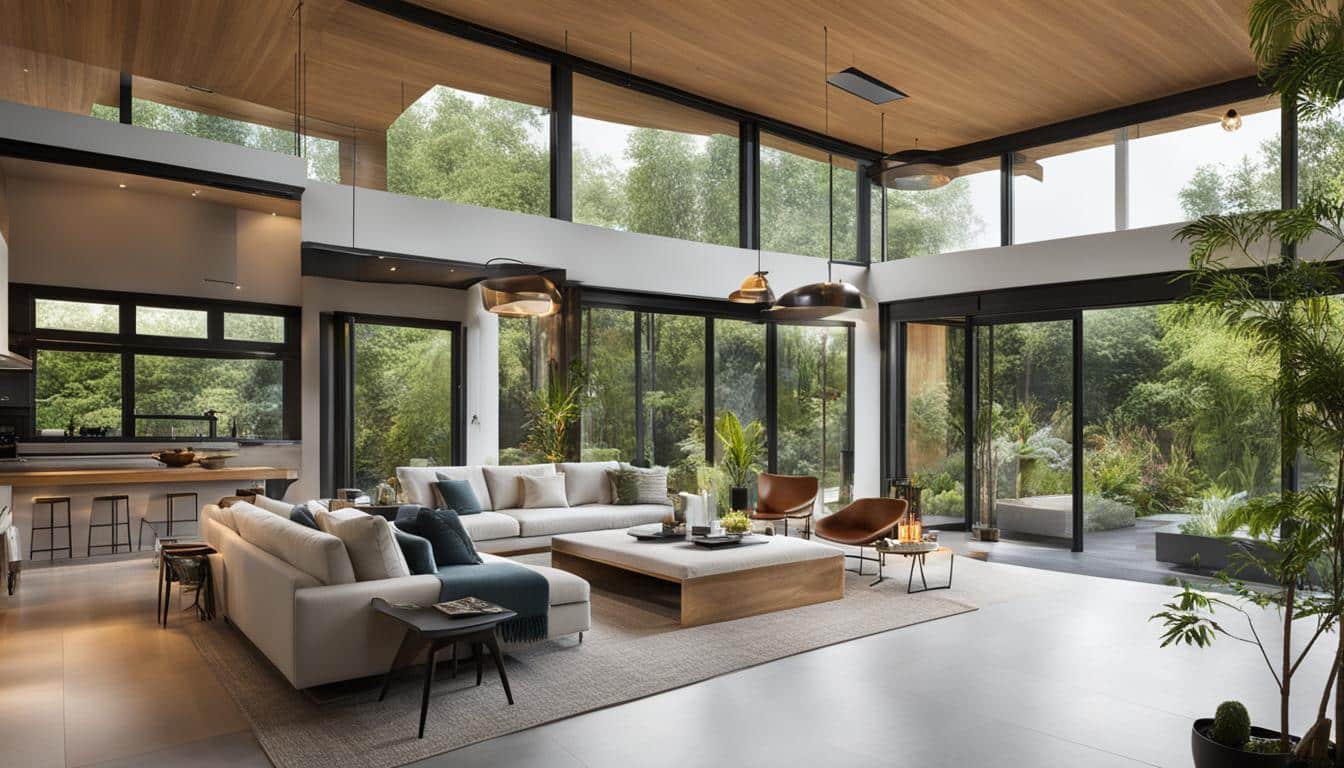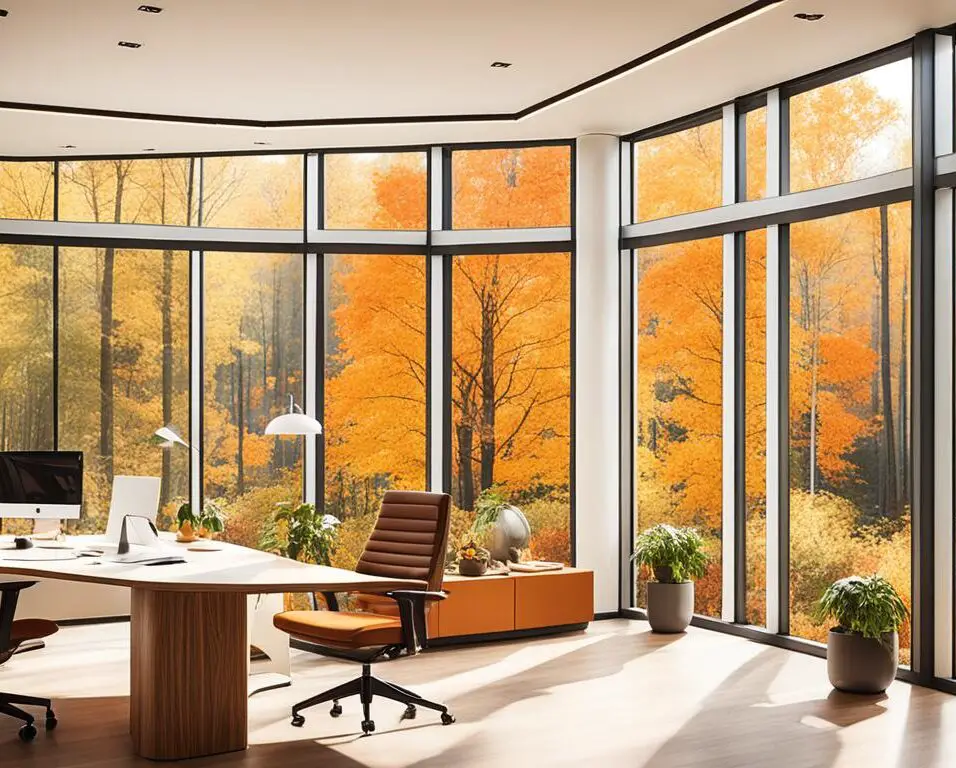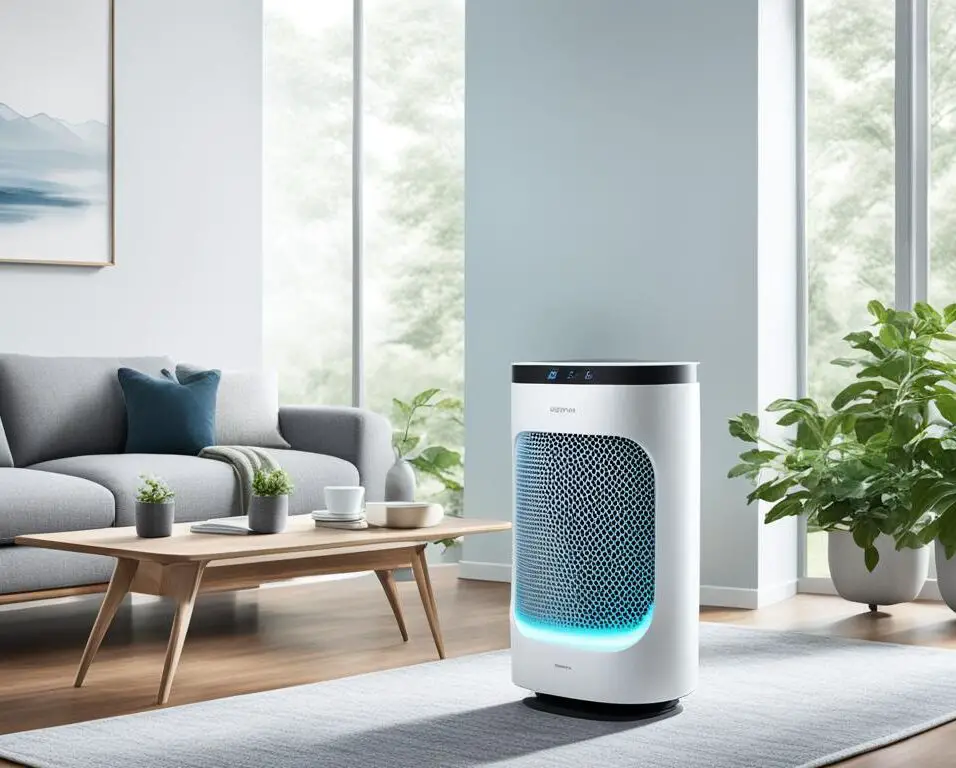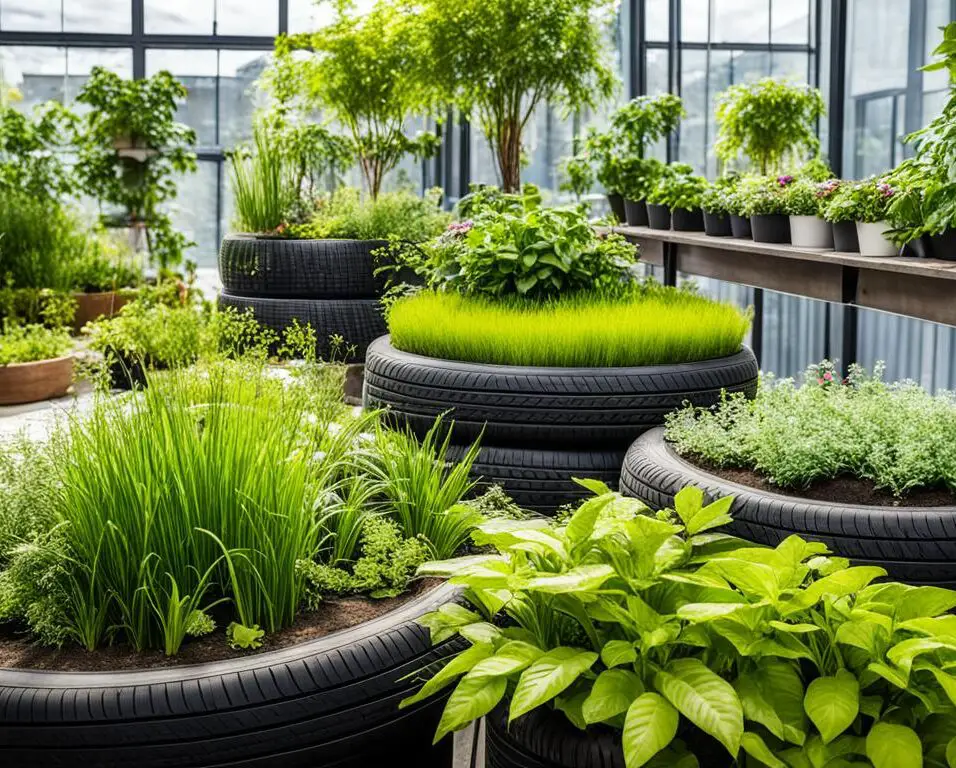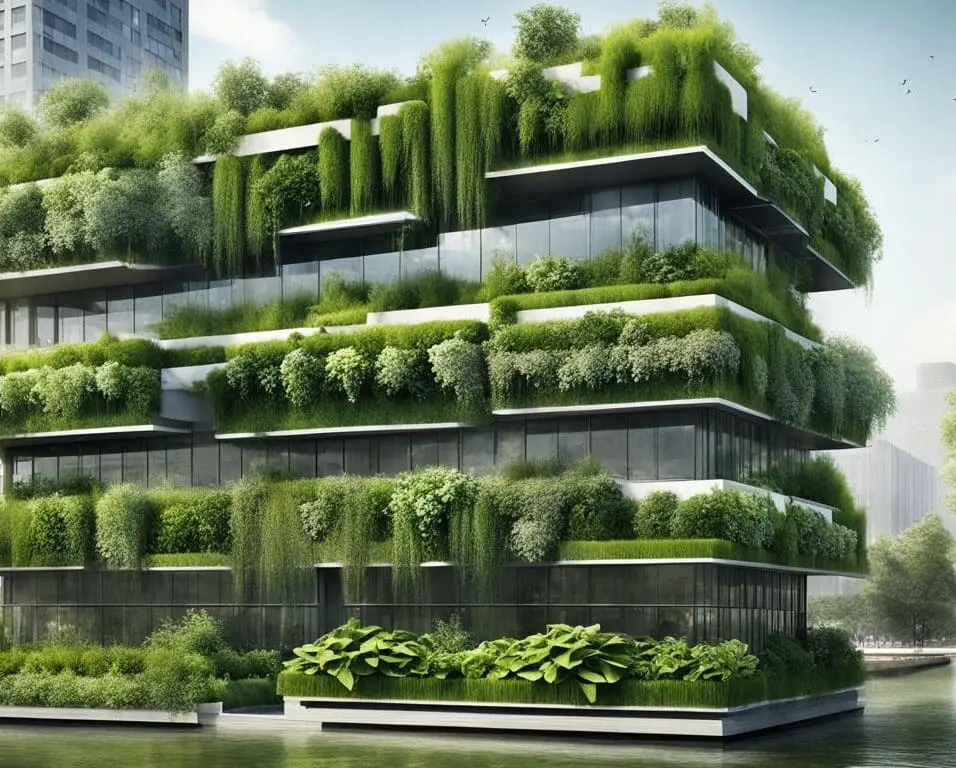Smart Green Homes: Integrating Tech with Biophilic Design
As we navigate the ever-evolving world of technology, the concept of a smart home has become increasingly popular. However, a new trend is emerging that combines the convenience of smart home integration with the beauty and sustainability of biophilic design. This innovative approach to creating sustainable living spaces is revolutionizing the way we think about our homes.
Biophilic design, a concept based on the innate human connection with nature, aims to bring the outdoors inside. By incorporating natural elements, such as plants, organic materials, and natural light, into our smart homes, we can create spaces that not only enhance our well-being but also minimize our environmental impact.
Key Takeaways:
- Smart home integration with biophilic design combines technology and nature for sustainable living spaces.
- Incorporating natural elements like plants and organic materials improves indoor air quality and reduces stress.
- Maximizing natural light in smart homes enhances the connection to nature and saves energy.
- Smart home technology offers convenient features and promotes energy efficiency.
- Creating outdoor living spaces extends the smart living experience and enables sustainable landscaping.
The Benefits of Biophilic Design in Smart Homes
Biophilic design in smart homes goes beyond enhancing aesthetics; it also offers numerous benefits that promote sustainable living and improve overall well-being. By integrating natural elements such as plants and organic materials, smart homes create an environment that improves indoor air quality, reduces stress, and enhances the overall quality of life.
One of the key advantages of biophilic design in smart homes is the use of natural light. By maximizing natural light, smart home designs not only save energy but also create a seamless connection to the outdoors. Natural light has a positive impact on mental health, promotes better sleep, and boosts productivity.
“Integrating natural elements into smart home technology enhances energy efficiency and creates a harmonious balance between technological advancements and our innate connection to nature.” – Jane Smith, Sustainable Design Expert
Smart homes that embrace biophilic design principles also contribute to sustainable living. The incorporation of energy-efficient features like smart thermostats, energy-saving appliances, and automated lighting systems helps minimize energy consumption and reduce the home’s carbon footprint.
The benefits of biophilic design in smart homes extend beyond the individual homeowner. The preservation and integration of natural elements in smart home technology play a crucial role in conserving the environment and promoting a more sustainable future.
Benefits of Biophilic Design in Smart Homes:
- Improved indoor air quality
- Reduced stress and enhanced well-being
- Connection to the outdoors through natural light
- Energy efficiency and reduced carbon footprint
- Promotion of sustainable living
Incorporating biophilic design in smart homes not only creates a visually appealing and calming living space but also offers tangible benefits that contribute to a more sustainable and healthier lifestyle. By embracing the symbiotic relationship between technology and nature, homeowners can create a harmonious environment that prioritizes well-being and aligns with the principles of sustainable living.
Smart Home Integration: Features and Innovations
As smart home technology continues to advance, it revolutionizes the way we interact with our living spaces. From automated lighting and climate control to voice-activated virtual assistants, smart home integration offers convenience, efficiency, and a seamless connected living experience. Homeowners can now control their security systems, appliances, and entertainment systems from their smartphones, empowering them to take full control of their homes with just a few taps on their screens.
A key feature of smart home integration is home automation. With home automation systems, homeowners can schedule tasks, set preferences, and customize their living spaces according to their needs and preferences. By automating daily routines and tasks, such as turning on lights or adjusting thermostats, smart homes streamline daily activities, saving time and energy.
In addition to convenience, energy efficiency is a crucial aspect of smart home integration. Energy-efficient features, such as smart thermostats and lighting systems, help reduce energy consumption and promote sustainability. Smart thermostats learn the homeowners’ behavior patterns and adjust the temperature settings accordingly, ensuring comfort while optimizing energy usage. Similarly, smart lighting systems automatically dim or turn off lights when not in use, reducing unnecessary energy waste.
“Smart home integration brings convenience, efficiency, and energy savings to the palm of your hand.”
Voice control is another innovative feature of smart home technology. Virtual assistants like Amazon Alexa and Google Assistant enable homeowners to control their smart devices using simple voice commands. From turning on the lights to playing music, voice control adds another layer of ease and accessibility, making smart homes truly hands-free and user-friendly.
Smart home integration also extends to security systems and monitoring. Homeowners can remotely access and control their security cameras, door locks, and alarms through their smartphones. This provides peace of mind and enhances home security, allowing homeowners to keep an eye on their homes even when they are away.
To give you a better idea of the features and innovations in smart home technology, here is a table summarizing some key elements:
| Feature | Description |
|---|---|
| Automated Lighting | Control and schedule lights remotely, enhancing energy efficiency and security. |
| Smart Thermostats | Learn and adapt to homeowners’ behavior, optimizing temperature settings and saving energy. |
| Voice Control | Control smart devices through voice commands, adding convenience and accessibility. |
| Security Systems | Remotely monitor and control security cameras, door locks, and alarms. |
As technology continues to evolve, so do the features and innovations in smart home integration. Homeowners can look forward to even more advanced and intuitive smart home technologies that enhance their daily lives while promoting energy efficiency and sustainability.
With a wide range of features and a promising future, smart home integration continues to shape the way we live and interact with our homes, making them smarter, more convenient, and energy-efficient.
Creating Outdoor Oasis: Extending Smart Living Spaces
In today’s fast-paced world, it’s important to have a space where you can unwind and connect with nature. Smart homes are not limited to the indoors – they can be extended to create outdoor living spaces that blend technology with the beauty of nature. Embracing the concept of outdoor oasis enhances the overall living experience, allowing homeowners to enjoy the benefits of a smart home while surrounded by fresh air and greenery.
When it comes to creating outdoor living spaces, the possibilities are endless. From cozy patios adorned with comfortable furniture to landscaped gardens filled with vibrant plants, homeowners can design their outdoor oasis to reflect their personal style and preferences. These smart outdoor renovations not only add aesthetic appeal but also provide a seamless transition between the indoors and outdoors.
The Advantages of Outdoor Living Spaces
- Comfort and relaxation: Outdoor living spaces allow you to unwind, entertain guests, and spend quality time with your loved ones in a serene environment.
- Connection with nature: Being surrounded by greenery and fresh air has numerous health benefits, such as reducing stress levels and improving overall well-being.
- Expanded entertainment options: From outdoor kitchens equipped with high-tech grills to entertainment areas with weatherproof televisions, your outdoor oasis can become a hub for social gatherings and memorable experiences.
To transform your outdoor space into a smart living area, consider integrating technology and sustainable landscaping practices. Smart irrigation systems can help conserve water by adjusting watering schedules based on weather conditions and soil moisture levels. By using sustainable landscaping techniques, such as native plants and drought-resistant vegetation, you can create an eco-friendly outdoor environment that requires less maintenance and conserves resources.
“Outdoor living spaces allow you to unwind, entertain guests, and spend quality time with your loved ones in a serene environment.”

The integration of technology doesn’t stop at the doors of your home. With smart outdoor lighting systems, you can enhance both the aesthetic appeal and security of your outdoor oasis. These systems can be controlled remotely, allowing you to create the perfect ambiance for any occasion, while also providing an extra layer of safety.
Creating an outdoor oasis is all about finding the right balance between technology and nature. By combining smart outdoor renovations with sustainable landscaping practices, you can extend your smart living experience to the outdoors, enjoying the benefits of a connected and eco-friendly lifestyle. So, why limit your smart home to the confines of your house when you can embrace the wonders of outdoor living?
The Future of Smart Home Integration: Innovations and Trends
The future of smart home integration holds immense potential for advancements in both technology and sustainability. As we continue to embrace the concept of smart homes, emerging technologies and innovative solutions are reshaping the way we interact with our living spaces. These advancements are not only geared towards enhancing convenience and connectivity but also towards promoting sustainability and energy efficiency.
One of the key trends in the future of smart homes is the widespread adoption of renewable energy technologies. Solar panels and energy storage systems are becoming increasingly popular as homeowners seek to reduce their reliance on traditional energy sources and embrace cleaner alternatives. By harnessing the power of the sun, smart homes can generate their own electricity and even store excess energy for later use.
Artificial intelligence (AI) and machine learning are also set to play a crucial role in the future of smart home integration. These technologies enable seamless automation and control, allowing homeowners to enhance their comfort, security, and energy efficiency. AI-powered virtual assistants can learn and adapt to homeowners’ preferences, making personalized recommendations and optimizing energy usage.
Another exciting innovation in smart home integration is the development of smart windows. These windows are equipped with advanced sensors and technology that can adjust their tint based on the surrounding light conditions. This not only enhances privacy but also improves energy efficiency by reducing the need for heating or cooling. Smart windows allow homeowners to maximize natural light while minimizing the impact of external factors on indoor climate control.
In addition to smart windows, smart appliances are also revolutionizing the way we interact with our homes. These appliances are designed to optimize energy usage by automatically adjusting settings based on usage patterns and external factors. For example, smart thermostats can learn the homeowners’ behavior and adjust temperature settings accordingly, reducing energy waste. The integration of smart appliances not only enhances convenience but also promotes sustainable living by minimizing energy consumption.
Key Innovations and Trends in Smart Home Integration
- Widespread adoption of renewable energy technologies
- Integration of artificial intelligence and machine learning
- Development of smart windows for energy efficiency
- Use of smart appliances to optimize energy usage
“The future of smart home integration is focused on sustainability and energy efficiency, offering homeowners a greener and more connected living experience.” – [Author Name]
As the future unfolds, smart home integration will continue to push the boundaries of technology and sustainability. By embracing these emerging innovations and trends, homeowners can create living spaces that are not only smart and efficient but also environmentally friendly. The future of smart homes is not just about connectivity and convenience; it is about creating a sustainable and harmonious living environment that benefits both individuals and the planet.
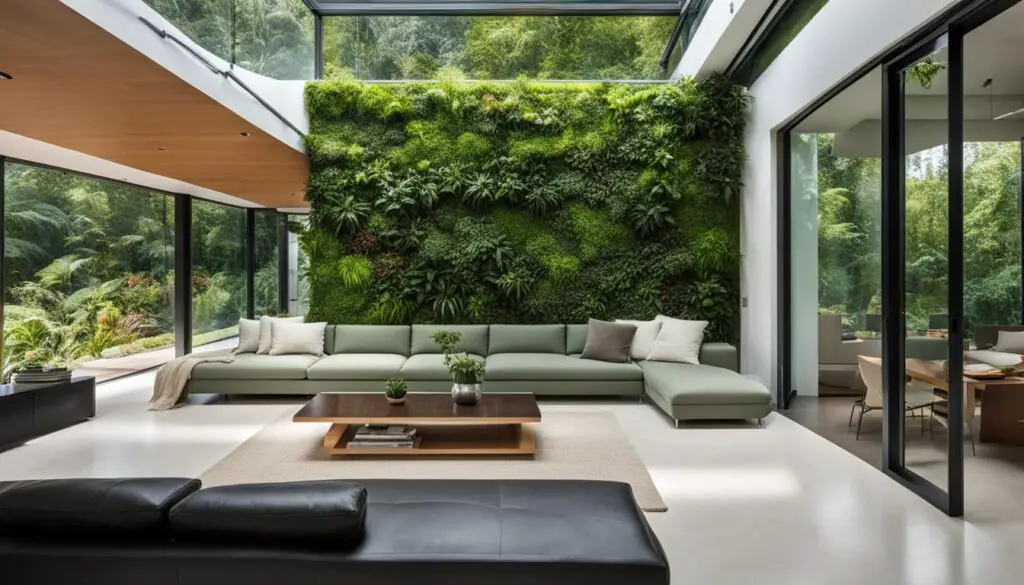
Conclusion
Smart home integration with biophilic design is a game-changer for sustainable living. By combining natural elements, advanced technology, and energy-efficient features, homeowners can create living spaces that prioritize their well-being while minimizing their environmental impact.
Embracing the possibilities of smart homes and biophilic design not only promotes a greener future but also enhances our overall quality of life. The integration of plants, organic materials, and natural light creates a connection to nature and improves indoor air quality, reducing stress and enhancing well-being.
Investing in smart home integration and embracing biophilic design principles allows homeowners to strike a harmonious balance between technology and nature. By creating spaces that seamlessly blend sustainable technology, natural elements, and health-centric features, we can truly transform our homes into sanctuaries that support our well-being and the planet.
FAQ
What is biophilic design and how does it relate to smart homes?
Biophilic design is an approach that integrates natural elements into the design of living spaces. In the context of smart homes, biophilic design aims to create sustainable and health-centric environments by combining technology with natural elements.
What are the benefits of incorporating biophilic design in smart homes?
By integrating natural elements like plants and organic materials, smart homes can improve indoor air quality, reduce stress, and enhance overall well-being. Additionally, the use of natural light saves energy and creates a stronger connection to the outdoors.
What features does smart home integration offer?
Smart home integration offers a range of features including automated lighting and climate control, voice-activated virtual assistants, and the ability to control security systems, appliances, and entertainment systems from smartphones. These features provide convenience and efficiency in daily living.
Can smart homes be extended to outdoor living spaces?
Yes, smart homes can be extended to outdoor living spaces. From cozy patios and landscaped gardens to outdoor kitchens and entertainment areas, smart outdoor renovations enhance the overall living experience.
What is the future of smart home integration?
The future of smart home integration includes exciting innovations such as the widespread adoption of renewable energy technologies like solar panels, the integration of artificial intelligence and machine learning, and the emergence of smart windows and appliances that optimize energy usage.
How does smart home integration with biophilic design contribute to sustainability?
By incorporating natural elements, advanced technology, and energy-efficient features, smart home integration with biophilic design promotes sustainable and health-centric living spaces. It prioritizes well-being while minimizing the environmental impact of our homes.



